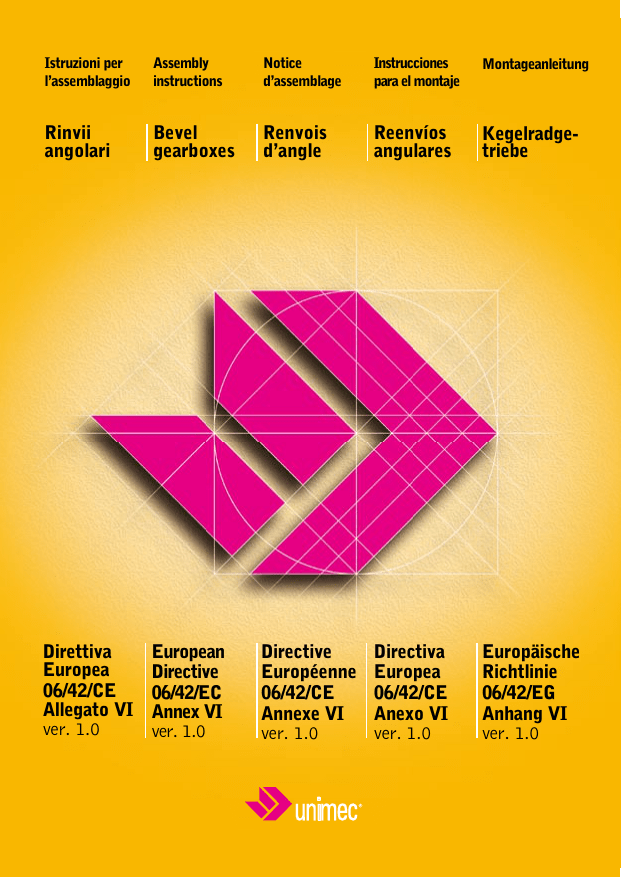Rinvii angolari Bevel gearboxes Renvois d`angle Reenvíos - Jens-S
advertisement

Istruzioni per l’assemblaggio Assembly instructions Notice d’assemblage Instrucciones para el montaje Montageanleitung Rinvii angolari Bevel gearboxes Renvois d’angle Reenvíos angulares Kegelradgetriebe Direttiva Europea 06/42/CE Allegato VI ver. 1.0 European Directive 06/42/EC Annex VI ver. 1.0 Directive Européenne 06/42/CE Annexe VI ver. 1.0 Directiva Europea 06/42/CE Anexo VI ver. 1.0 Europäische Richtlinie 06/42/EG Anhang VI ver. 1.0 Translation of the original instructions edited according to annex I - 1.7.4.1 A bevel gearbox is a mechanical transmission whose function is to transmit rotary motion in 90° angles. Gleason® gears are inside the casing and are mounted on shafts of different geometries (hollow, broached, projecting, reinforced). EXPLODED SPARE PARTS Models: RC - RR - RB - RA - RS - RP - RX - RZ - RM* - RIS and motorized 1 Casing 2 Cover 3 Hub 3.1 Motor flange 4 Shaft (hollow-protruding -broached - with shrink disk) 5 Bevel gear 5.1 Bevel pinion 6 Hub shaft 18 17 6.1 Drive shaft 2 7 Spacer 8 Gasket 8.1 Gasket for motorisation 9 Lock washer 10 Bearing 10.1 Bearing for motorisation 11 Bearing 12 Stop ring 12.1 Stop ring for motorisation 8 13 Seal 13.1 Seal for motorisation 14 Seal 15 Key 16 Key 17 Bolt 18 Washer 19 Bolt 20 Filling plug 21** Hub cover 22** Bolt 8 14 11 5 7 4 1 20 16 5.1 9 19 11 16 14 6 15 16 18 19 10 3.1 13.1 5.1 10.1 3 10.1 8.1 12.1 21 15 10 6.1 13 22 18 9 17 12 8 2 10 18 * For the RM model, gear and pinion are inverted ** (sizes 166 - 200 - 250 - 350 - 500) Refer to the drawings in the general catalogue for a larger view of the RIS, RE and RH models and their spare parts. 17 APPLICABLE ESSENTIAL SAFETY REQUIREMENTS ANNEX I 1.1.3 Materials and products The bevel gearboxes are made of metallic materials (cast-iron, steel) and polymeric gaskets. In case that the supply includes electromechanical components, compliance to the ROHS regulation is ensured for these components. The whole range of bevel gearboxes has internal mineral oil lubrication, except size 54, which is grease lubricated; these lubricants do not report any R or S phrase on the safety sheet. Even if the gearbox tightness is ensured, occasional lubricant leakages from the gaskets may occur. 1.1.5 Design of the partly completed machinery to facilitate its handling It is mandatory to verify the weight of the component to be transported on the transportation document. If the weight exceeds the manual transport limits, it is necessary to arrange appropriate means of transportation that is capable of supporting this load. In any case, it is not possible to manually transport loads equal or bigger than 166. The transmission center of gravity is located inside the casing, even though it hardly coincides with its geometric center. Always pay attention to adjustments during the transport before reaching a position of equilibrium. The table below shows an indicative level of the weights of a two transmission gears depending on the size. Weight [kg] Weight [kg] 54 86 110 134 166 200 2 6,5 10 19 32 55 250 350 500 32 42 55 103 173 1050 29 48 82 11 In the presence of asymmetrical engines or masses, be aware of the possibility of overturning the object. There are different ways to transport a bevel gearbox before its incorporation into a machine: a)Manual transport: avoid taking the gearbox from the shaft projections, because an overturn can be triggered. Pay attention to residual lubricants that can cause sliding. Pay attention to sharp corners (1.3.4). b)Transport hung by eye-bolts: fasten the eye-bolts on the gearboxes fastening holes only. Pay attention to the swinging during the transport. c)Transport hung by magnet: watch out for swinging during the transport. d)Transport hung by bands: watch out for swinging during the transport. Pay careful attention if you fasten the stripes on the shaft projections, because an overturn can be triggered. e)Sustained transport: pay attention to residual lubricants on surfaces that can cause sliding, especially in phases of acceleration and deceleration. During the warehousing, the gearboxes must be protected so that dust or foreign bodies cannot be deposited. It is necessary to pay particular attention to the presence of corrosive or salty atmospheres. We also recommend: a)periodically rotating the shafts to ensure appropriate lubrication of the internal parts and to avoid the drying out of the gaskets causing lubricant leakages. b)completely refilling the unit of all gearboxes without lubricant with anti-rust oil. c)protecting the shafts with appropriate products. 1.2.3. Starting The bevel gearboxes can be driven either on the high speed shaft or on the low speed shaft. Given that these are reversible transmissions, the reverse motion is possible, so pay careful attention. 12 Every bevel gearbox comes with lubricant which allows the proper functioning of transmission. Those with a “put oil” label are an exception. For these, the installer must fill the lubricant up to the given level and must do so when the gears are not in motion. It is recommended to avoid overfilling to prevent overheating, noise, increases of the internal pressure and loss of power. If necessary, the gearbox may be put in operation at maximum load immediately. If circumstances allow it, it is recommended to let it work with an increasing load and reach the maximum load after 20-30 hours of operation. Every precaution must be taken in order to avoid overloading in the early stages of operation. Temperatures reached by the gearbox in these early stages will be higher than they will be after breaking it in. The selector switch, present on the RIS model, must be handled only when the transmission is stopped. 1.2.6 Failure of the power supply Bevel gearboxes transmissions are reversible; therefore the reverse motion is possible. Pay attention to all the consequences that could arise from this event. 1.3.2 Risk of break-up during operation The bevel gearbox, if properly sized as specified in the general catalog (taking care to never exceed the indicated maximum power and torque values), may fail during the operation due to a deterioration of its constituent components, both fixed and mobile. The causes of damage may be different: a)Deficiency or deterioration of internal components lubrication: the oil used for the lubrication of the internal components must be completely replaced after 3.000 hours of operation. In the presence of leakage it is necessary a top-off the lubricant, bringing the quantity back to the factory values (in the table below). 13 Inner lubricant quantity [litres] Inner lubricant quantity [litres] 54 86 110 134 166 200 0,015 0,1 0,2 0,4 0,9 1,5 250 350 500 32 42 55 3,1 11 28 1 1,8 3,7 In case of topping-off or replacement, it is necessary to use a lubricant having the characteristics listed in the catalog according to DIN 51517-3, in order to guarantee the same performance capabilities. The presence of a vertically oriented hub (3) must be reported when ordering, so that a sort of reservoir can be set in place during assembly, in order to ensure durability. This hub is indicated with a graphic sign saying “alto”. b)Methods of lubrication: there are two methods of lubrication for the gearbox’s internal parts: by shaking and by force. The lubrication by shaking does not require external intervention: when the high speed shaft rotation speed is less than that which is reported in the chart below, its operation ensures that the lubricant reaches every component in need. For rotation speed exceeding the reported values, it may happen that the gears’ peripheral speed is such as to create centrifugal forces capable of overpowering the lubricant’s adhesiveness. Therefore, in order to ensure proper lubrication, a supply of a pressurized lubricant (suggested 5 bar) with its appropriate cooling circuit is necessary. For very low rotation speed of the high speed shaft (less than 50rpm), the phenomena generating the shaking may not be triggered correctly. c)Failure due to the wear of subject components: the constituent components subject to friction suffer the effects of wear. Gears (5 and 5.1) are the most vulnerable to wear. The failures on the bearings (10 and 11) cause the transmission to stop, while the wear of the gaskets (8.13 and 14) favors the leaks. 14 input revolution speed [rpm] 4000 3000 3000 3000 3000 3000 2500 2400 2000 2000 1800 1500 1000 1100 700 0 54 86 110 134 166 200 250 RE32 RH32 RE42 RE55 RH42 RH55 500 350 500 size d)Lateral loads: it is advisable to check, on the general catalog, the capability to support radial and axial loads acting on the shafts, in order to avoid overburdening the bearings. For this reason you must pay attention to the project values, to the loads originated from misalignments (see part E) and to the transmission components mounted on the shafts themselves. e)Misalignments: when installing a gearbox in a system, it is necessary to pay attention to the alignment of the axes. Without proper alignment, the bearings would suffer overloads, would heat up anomalously and, increasing the group noise, would suffer an increased wear with a decrease of the gearbox’s useful life as a consequence. The transmission installation is needed in order to prevent movement or vibration. f)Corrosion: it is necessary to verify the corrosion resistance of the constituent components depending on the work environment. 1.3.4 Risks due to surfaces, edges or angles The bevel gearboxes have sharp edges that, even if blunted, can present both blunt and sharp residual risks. 1.3.6 Risks related to variations in operating conditions Model RIS bevel gearboxes, through the selector movement, may represent different rotation directions or a neutral position. Pay attention to the selected direction and remember that the selector may be handled only when the transmission is still. 15 1.3.7 Risks related to moving parts Bevel gearboxes shafts are non-encased, rotating parts. Pay attention to their movement. 1.3.9 Risks of uncontrolled movements Bevel gearboxes, because of their inherent reversibility, may present drifts from stopping position if not properly restrained. 1.5.4 Errors of fittings Rotation directions are stamped on the casing in order to avoid mounting errors. However, it is recommended to check them before mounting. Here are some of the most common constructive forms. Please refer to the general catalog for a complete list. c1 c2 c3 c4 c5 s1 s2 s3 s4 s5 s6 s7 s9 s10 s14 s26 s27 s31 s32 s33 1.5.5 Extreme temperatures Because of its nature as a mechanical transmission, the bevel gearbox tends to heat up. Residual risks caused by hot surfaces remain during the operation and cooling stages. 16 1.5.8 Noise Because of its nature as a mechanical transmission, the bevel gearbox emits noise during the operation. 1.5.9 Vibrations Because of its nature as a mechanical transmission, the bevel gearbox, during the operation, may be an active source of vibration, especially in large structures and in presence of several transmission parts. It should be noted that active vibrations impacting the gearbox may reduce the useful life. 1.6.1 Partly completed machinery maintenance Because of that which was mentioned in paragraph 1.3.2, in the standard use conditions (ambient temperature 20°C, working without shock, gearbox checked to equivalent power as reported on the general catalog), it is necessary to arrange periodic inspections at least once a month. During these inspections it is necessary to ensure the absence of lubricant leaks from the gaskets and the absence of anomalous noises with frequency/revolution. Restore the correct lubricant amount inside the casing as necessary. At least once a year it is necessary check the transmission status more thoroughly: slacks measurement, wear phenomena, refill with new lubricant, and replacement of critical components. These inspections must be more frequent for more demanding conditions of use. Maintenance operations must be made when the transmission is not in use and by qualified persons. If necessary, please check on the website for the nearest contact and call for assistance. 1.7.3 Marking of partly completed machinery Every bevel gearbox is marked with a metallic plate showing the Unimec name and logo, a contact reference, model, size, constructive form and the transmission serial number. With the latter, it is possible to trace every detail regarding this component life, from the supply issue to its delivery. Bevel gearboxes, because of their partly completed nature, cannot be marked “CE”. Also, for this reason, they cannot be marked according to the ATEX regulations, even if they can be considered “components suitable for the application in potentially explosive atmospheres”, after completing the related questionnaire and after the favorable opinion of the technical office. 17 Unimec via del Lavoro 20 | 20040 Usmate-Velate (MB) | Italia tel. +39.039.6076900 | fax +39.039.6076909 info@unimec.eu Unimec France 29, Rue des Cayennes | Z. A. Boutries BP 215 | 78702 Conflans Cedex | France tel. +33.1.39196099 | fax +33.1.39193594 unimecfrance@unimec.eu Unimec Hispania C/Permanyer 34 | 08025 Sabadell (Barcelona) | España tel. +34.93.1147067 | fax +34.93.1147068 unimechispania@unimec.eu Unimec Triveneto via della Tecnica 10 | 35035 Mestrino (Pd) | Italia tel. +39.049.9004977 | fax +39.049.9004524 unimectriveneto@unimec.eu www.unimec.eu


